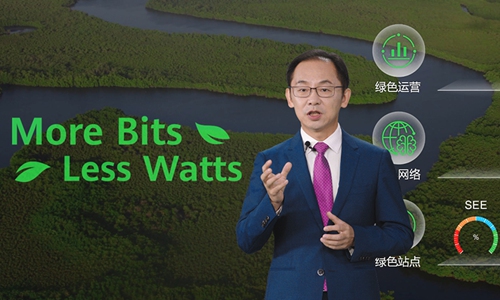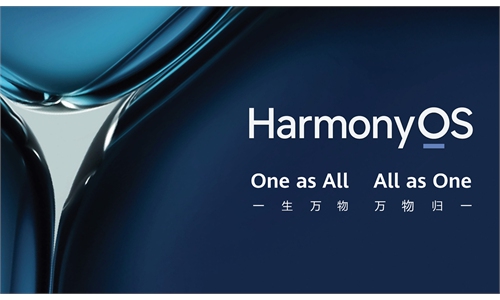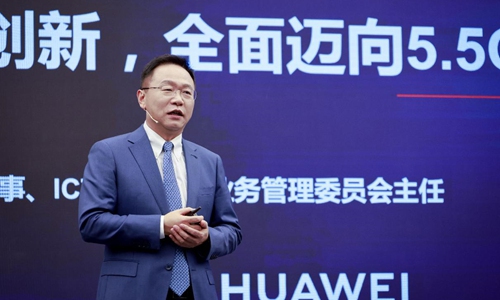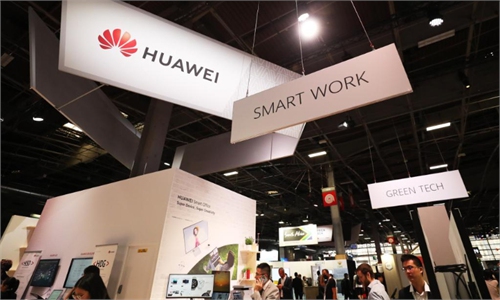
Ryan Ding, President of Huawei's Carrier Business Group Photo: Courtesy of Huawei
On the second day of the Win-Win·Huawei Innovation Week, Ryan Ding, President of Huawei's Carrier Business Group, stressed the need for operators to prioritize energy efficiency in his keynote speech titled "Green ICT for New Value," calling for the establishment of a standard and an industry-wide indicator system for energy efficiency.
"Every major advancement in history has been accompanied by a significant improvement in the energy efficiency of information transmission. The increase in carbon emissions generated by exploding data traffic will become a global problem that must be tackled in the next five to ten years. Increasing energy efficiency will be the way forward," Ding explained.
According to third-party research, data traffic generated by digital services is expected to grow by 13-fold over 2020 by 2030. This means that, if energy efficiency improvements are not made, the ICT industry's energy consumption and carbon emissions will see a 2.3-fold increase. According to ITU, the ICT industry will need to reduce its carbon emissions by at least 45 percent by 2030 to meet the United Nations Framework Convention on Climate Change (UNFCCC) Paris Agreement's goal.
"We are now facing an unprecedented challenge: As more and more industries are going digital, the demand for data will rise sharply, which will result in a surge in energy consumption. In the meantime, the whole world is working to combat climate change, and the ICT industry must urgently achieve carbon peak and carbon neutrality," Ding said.
Improvements to energy efficiency will benefit operators in three ways. First, user migration, site upgrades, and network power reduction will bring them OPEX savings. Second, improved energy efficiency will support the migration of 2G and 3G users to 4G and 5G services. Third, operators' efforts to reduce carbon footprint will positively impact the environment in future, helping them better fulfill their social responsibilities.
To help operators achieve these goals, Huawei has proposed a three-layer solution: green sites, green networks, and green operations. First, they have developed solutions to improve site energy efficiency by adopting a highly integrated design, using new materials, and moving main equipment and power supply units outdoors. Second, the company's simplified network architecture makes forwarding faster and supports the construction of simplified, all-optical, and intelligent networks. Finally, at the operations level, Huawei offers a solution that generates and distributes optimization policies while making energy efficiency more visualized and manageable.
So far, these green development solutions have been deployed for operators in more than 100 countries. In Germany, for example, Huawei's PowerStar solution has helped realize minute-level energy efficiency self-optimization, improving energy efficiency greatly. In Spain, Huawei's optical cross-connect (OXC) solution has been deployed on a customer's backbone network, increasing energy efficiency by 81 percent and reducing costs by 29 percent. In Turkey, Huawei has deployed its green site solution for a customer, where equipment rooms are replaced with cabinets, eliminating the need for equipment rooms and air conditioners. The solution is expected to save 19,000 kilowatt-hours of electricity per site per year.
Huawei and its operator partners have already worked together to increase their "carbon handprint" by empowering carbon-intensive industries to boost energy efficiency using ICT solutions. The emissions reduction they enable can be 10 times their own emissions. Many success stories have already been seen in key carbon-intensive industries including ports, coal mining, and steel production.
At the end of his speech, Ding called on the establishment of a unified, industry-wide indicator system as this would help establish baselines against which energy efficiency can be measured and serve as a guide for the green development of the ICT industry as a whole. Ding closed by his speech saying, "Huawei is ready to work with operators and create new value with green ICT."
The NCIe energy efficiency indicator system proposed by Huawei has been approved by ITU-T SG5 and is now in the process of public consultation.
The Win-Win·Huawei Innovation Week is held from Monday to Thursday in Shenzhen, South China's Guangdong Province. Together with global operators, industry professionals, and opinion leaders, we dive into topics such as 5.5G, green development, computing networks, and digital transformation to envision shared success across the digital economy.



